Здравствуйте, гость ( Вход | Регистрация )
 8.1.2015, 11:44 8.1.2015, 11:44
Сообщение
#1
|
|
 Активный участник    Группа: Пользователи Сообщений: 394 Регистрация: 26.1.2009 Из: Екатеринбург Пользователь №: 10035 |
Кэти Марлей у себя на страничке в фэйсбуке выложила интересную картинку о правильных движениях апсо
 по верхней картинке пишется, что от таких движений получается максимальная эффективность и они сбалансированны благодаря вымахау и толчку, а на второй они типа "сбалансированны" но очень ограничены. Короче движения шитцу. В комментариях к ее посту пишет и она сама про шициков, особенно про то , что нынешние судьи это любят (ох, не могу не согласиться)))) по верхней картинке пишется, что от таких движений получается максимальная эффективность и они сбалансированны благодаря вымахау и толчку, а на второй они типа "сбалансированны" но очень ограничены. Короче движения шитцу. В комментариях к ее посту пишет и она сама про шициков, особенно про то , что нынешние судьи это любят (ох, не могу не согласиться))))"Шитцу, в AKC является той породой - декоративная собачка. Лхаса является Охранником внутри дома, чье происхождение из резкого высотного климата. Шитцу РАЗРЕШАЮТ иметь строго декоративную походку, поскольку они живут на уровне моря и в общем то их предназначение пройти от подушки до миски с едой. Апсо следует за кочевыми семьями через горные перевалы или по крайней мере должен жить в 4000-метровой высоте и не может позволить себе потратить впустую энергию на подбрасывание ног высоко." -------------------- |
|
|
|
 |
Ответов
 16.1.2015, 11:58 16.1.2015, 11:58
Сообщение
#2
|
|
 Активный участник    Группа: Пользователи Сообщений: 2362 Регистрация: 29.5.2008 Из: Екатеринбург Пользователь №: 5 |
Еще одна статья от Кети Марлей - про связь движений с анатомией (наклон тазовой кости)
Movement and the Pelvic Angle C. Marley, M.D. 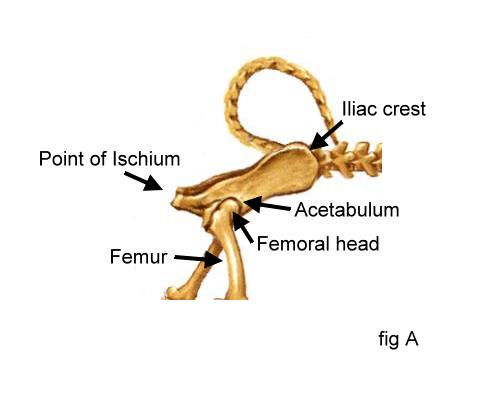 To understand how the pelvic angle of the Apso affects its movement, we must first understand the normal anatomy of the canine and the action of the hip joint. The pelvic angle is defined for the purposes of this article as the angle of the long axis of the pelvis from iliac crest to distalmost point of ischium, relative to the horizontal. (fig. A). The normal pelvic angle in the canine is about - 30 degrees. The part of the pelvis which attaches to the lumbar spine and tail is the sacrum, which is made up of several fused segments of the spine itself. Because the apso carries it's tail well over the back, the tail is "set on" in a higher position than in low-tailed breeds. This higher tailset is achieved by a slight tipping of the sacrum, so that the pelvic angle in this breed is often somewhat less than the normal (wolf type) 30 degree angle and more often about 20 - 25 degrees. (fig 1) 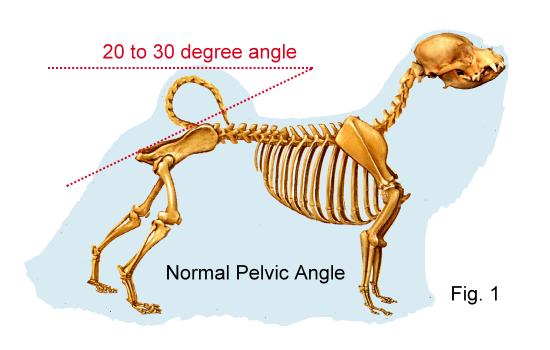 The femur moves in the hip socket (Acetabulum) by means of a ball joint. There is quite a range of movement within the socket, but it is not unlimited. The movement has a forward and backward limit imposed by the dimensions of the acetabulum, the shape of the femoral head, and by the ligaments and muscles surrounding the joint. This normal range of movement allows the rear foot to be brought well under the dog, contacting the ground and gripping the surface to propel the body forward. Finally at the end of the stride, the foot is picked up and immediately begins a recovery to a forward position. The normal range of motion allows maximal contact with the ground. In the normal recovery phase, the foot remains fairly close to the ground: the foot raised only so high as to allow adequate clearance. (fig.3) 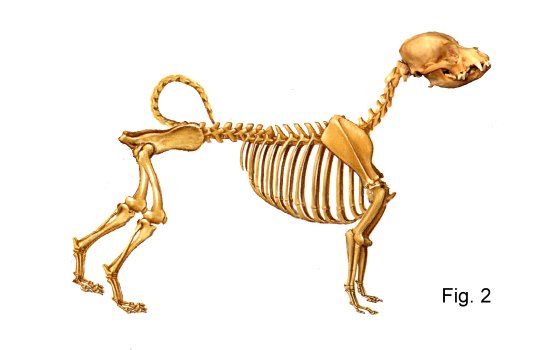 The flat pelvis is shown in fig 2. Compare it to the normal (fig 1). Dogs with this flat or tipped pelvis often have a straight shoulder (upright scapula), lacking layback of shoulder. (Figure 2 does not illustrate that - but shows a normal front with the flat pelvis) Another frequent effect of the flat or tipped pelvis is a lordotic or swaybacked lumbar spine resulting from the angle of attachment of the spine. The normal canine loin (lumbar spine) is slightly arched allowing for strength and the action of the "rearing" muscles. Weakness in this area can result in serious spinal problems. A graphic depiction of all three problems (slack loin, flat pelvis, and upright scapula) is seen in fig.2b) 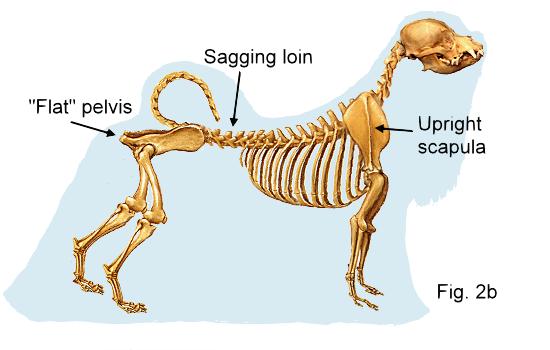 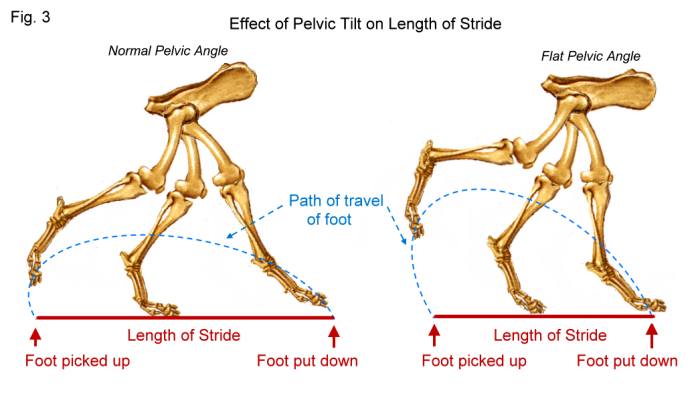 The flat or tipped pelvis changes the mechanics of rear movement. (fig 3) Because of the abnormal angulation of the pelvis, the range of motion of the femur, and thus the entire rear leg, is limited anteriorly and exaggerated posteriorly. The foot cannot be brought forward to it's normal extension under the dog, but rather strikes the ground very nearly under the hip joint. The arc of motion of the femur then forces the foot to leave the ground prematurely and swing in the air to an elevated position. Recovery begins at this abnormally high position, which can be seen as an exaggerated vertical piston-like action in the rear. As result of the abnormal pelvic tilt, and the physical limitation of rotation of the hip joint, the anatomical arc of motion of the femur is unable to achieve a normal length of stride, and a good deal of the energy meant to propel the dog is wasted as motion in the air. The dog compensates for this limitation of stride and propulsion by taking extra steps to cover the same ground. This mechanical disadvantage is inconsistent with the breed origin of this animal - a dog which must be able to thrive at very high elevation in the Himalayas. At 12,000 to 16,000 feet, wasting energy is wasting oxygen, incompatible with survival, and therefore untypical of the true Lhasa Apso. It seems that many observers tend to equate furious action (many small steps) and high flinging of the rear legs with "drive" and interpret this "windmilling" activity in the rear as good movement. In fact, some breeders have actively selected for this type of construction and movement. However if one stops to consider that in any land-based locomotion, "drive" only takes place with the traction on the ground, it becomes obvious that feet flailing in the air are not contributing to forward propulsion, however exciting it may look! Smooth, efficient movement depends on balanced movement of the limb both in forward reach and backward extension where the "rubber meets the road" - ON THE GROUND. -------------------- |
|
|
|
Сообщений в этой теме
 Anny Занимательная Головоломка Про Движения 8.1.2015, 11:44
Anny Занимательная Головоломка Про Движения 8.1.2015, 11:44
 Anny RE: Занимательная Головоломка Про Движения 8.1.2015, 11:45
Anny RE: Занимательная Головоломка Про Движения 8.1.2015, 11:45
 Anny - тут возмущения народа
Так вот, риторический воп... 8.1.2015, 11:56
Anny - тут возмущения народа
Так вот, риторический воп... 8.1.2015, 11:56

 OriSilk Цитата(Anny @ 8.1.2015, 13:56) Так вот, р... 11.1.2015, 16:34
OriSilk Цитата(Anny @ 8.1.2015, 13:56) Так вот, р... 11.1.2015, 16:34
 Anny Фотка бобы в месяцев 6 и в полтора года. Вроде дви... 8.1.2015, 12:05
Anny Фотка бобы в месяцев 6 и в полтора года. Вроде дви... 8.1.2015, 12:05
 Элеонора Лея. 8.1.2015, 15:38
Элеонора Лея. 8.1.2015, 15:38
 Irena Советую прочитать:
РАШЕЛЬ ПЕЙДЖ ЭЛЛИОТ
ДВИЖЕНИЕ СО... 8.1.2015, 17:54
Irena Советую прочитать:
РАШЕЛЬ ПЕЙДЖ ЭЛЛИОТ
ДВИЖЕНИЕ СО... 8.1.2015, 17:54

 Anny Цитата(Irena @ 8.1.2015, 17:54) Советую п... 8.1.2015, 19:03
Anny Цитата(Irena @ 8.1.2015, 17:54) Советую п... 8.1.2015, 19:03
 Irena Аня, согласна. Его книга просто настольное пособие... 9.1.2015, 14:29
Irena Аня, согласна. Его книга просто настольное пособие... 9.1.2015, 14:29
 OriSilk ну у нас на производителях из КайЛаШа и Вери Верса... 11.1.2015, 16:22
OriSilk ну у нас на производителях из КайЛаШа и Вери Верса... 11.1.2015, 16:22
 Anny Цитата(OriSilk @ 11.1.2015, 17:34) я не д... 11.1.2015, 18:04
Anny Цитата(OriSilk @ 11.1.2015, 17:34) я не д... 11.1.2015, 18:04

 OriSilk Цитата(Anny @ 11.1.2015, 20:04) Вообще, н... 11.1.2015, 22:20
OriSilk Цитата(Anny @ 11.1.2015, 20:04) Вообще, н... 11.1.2015, 22:20
 Irena Не стоит также забывать что анатомия собаки не про... 12.1.2015, 17:19
Irena Не стоит также забывать что анатомия собаки не про... 12.1.2015, 17:19
 Элеонора Движения апсо... в описании как надо судить апсо, ... 14.1.2015, 9:53
Элеонора Движения апсо... в описании как надо судить апсо, ... 14.1.2015, 9:53

 OriSilk Цитата(Элеонора @ 14.1.2015, 11:53) Движе... 16.1.2015, 11:48
OriSilk Цитата(Элеонора @ 14.1.2015, 11:53) Движе... 16.1.2015, 11:48
 OriSilk вот статья с сайта мисс Кети Марлей
Angulation a... 16.1.2015, 11:54
OriSilk вот статья с сайта мисс Кети Марлей
Angulation a... 16.1.2015, 11:54
 Doris Блиииин! Еще бы Аня это перевела, чтобы нормал... 16.1.2015, 13:25
Doris Блиииин! Еще бы Аня это перевела, чтобы нормал... 16.1.2015, 13:25
 Anny Как с международным правом расправлюсь, так переве... 18.1.2015, 2:16
Anny Как с международным правом расправлюсь, так переве... 18.1.2015, 2:16  |

|
Текстовая версия | Сейчас: 27.7.2025, 12:47 |
Форум IP.Board © 2025 IPS, Inc.










